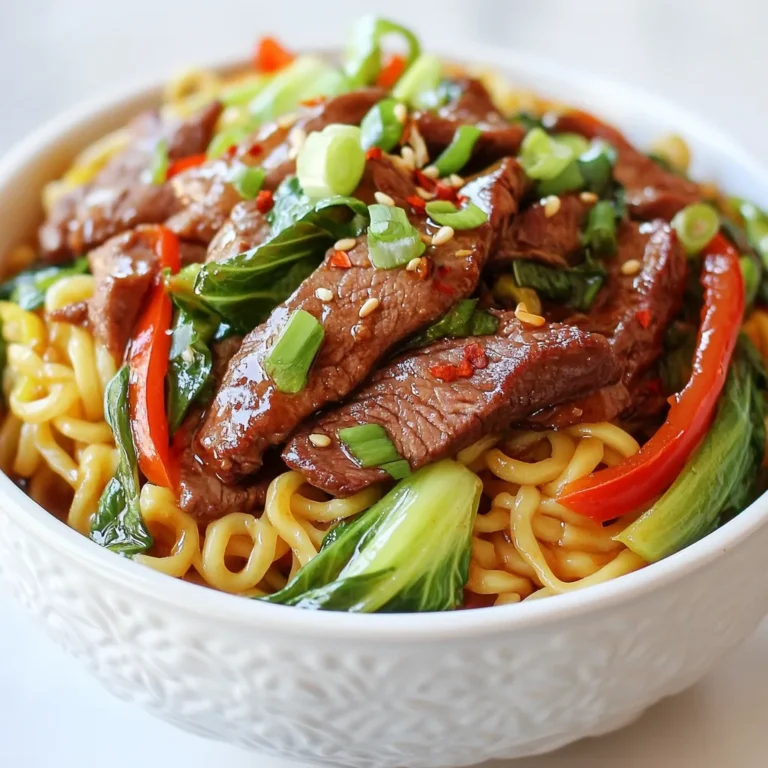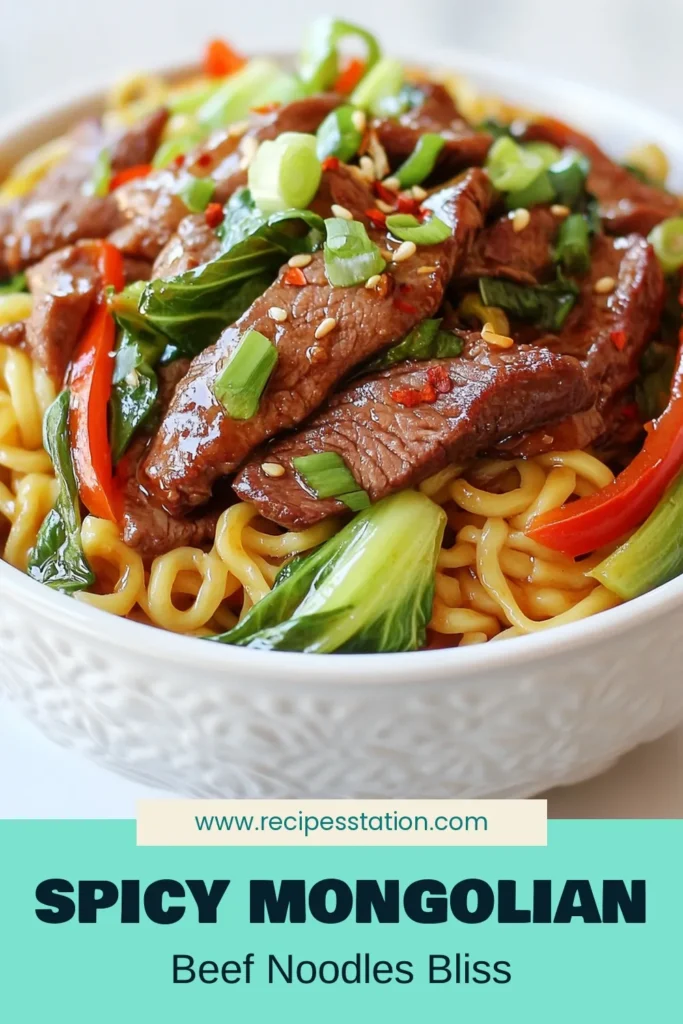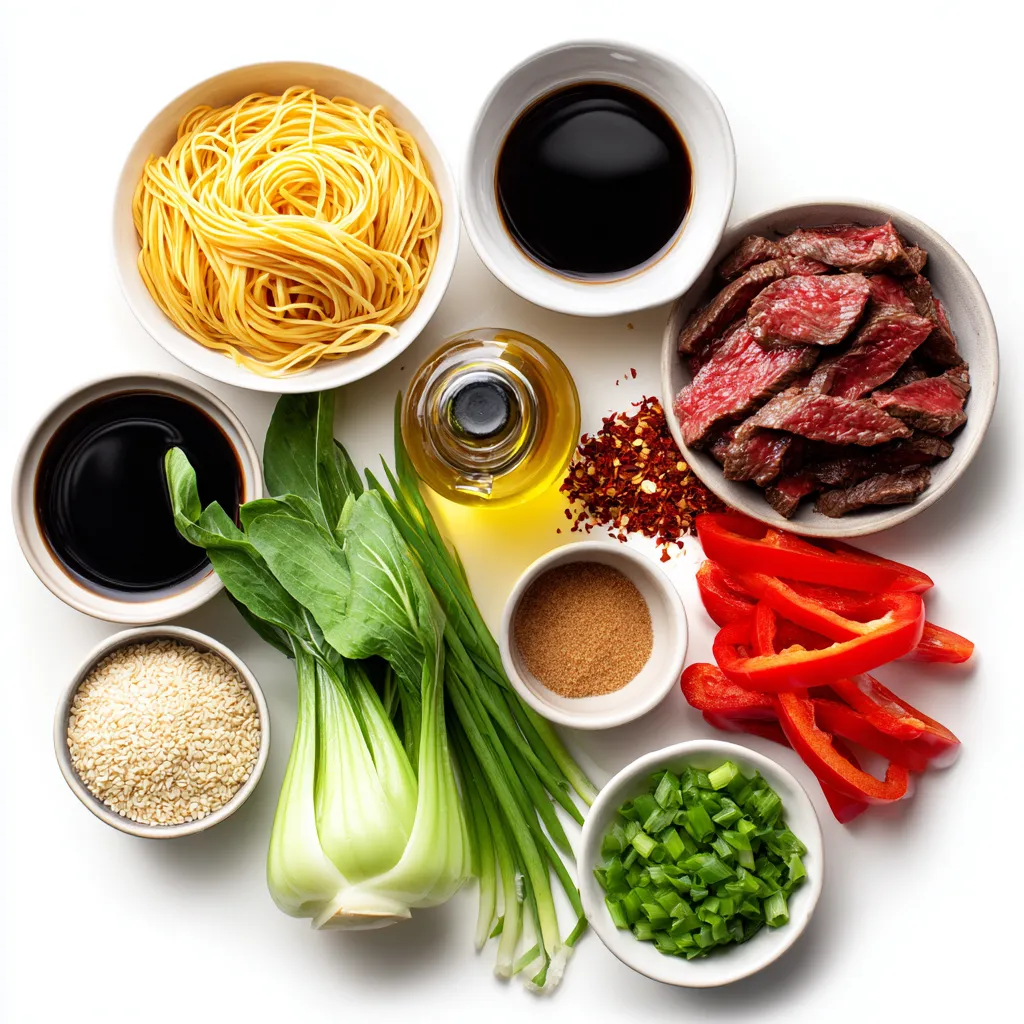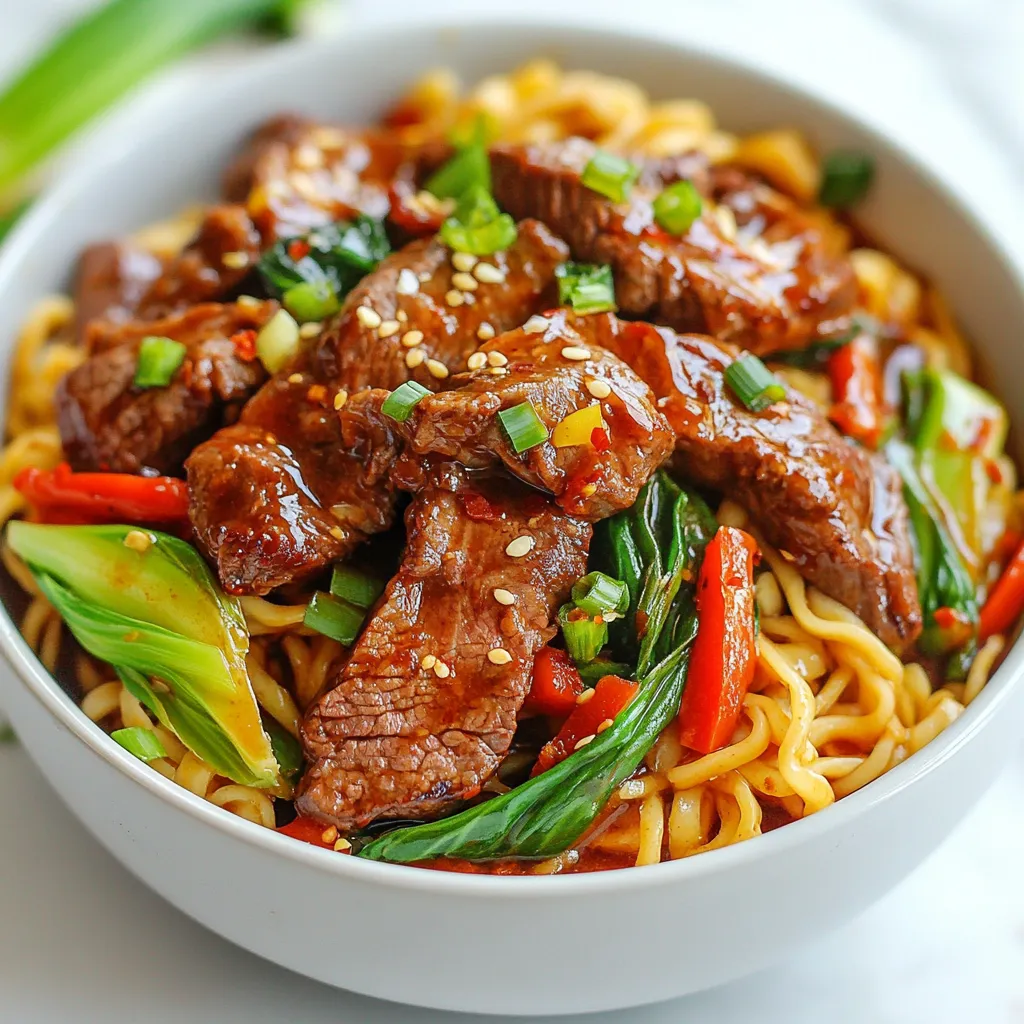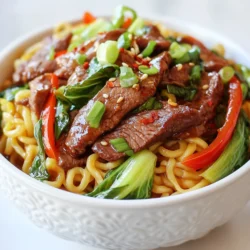WANT TO SAVE THIS RECIPE?
Are you ready to spice up your weeknight dinners? Mongolian Beef Noodles are both flavorful and easy to make! This dish combines tender beef, fresh veggies, and rich sauces for a meal that everyone will love. In this article, I’ll guide you through the simple steps and key ingredients to create your own delicious Mongolian Beef Noodles. Let’s dive in and transform your kitchen into a vibrant Asian eatery!
Why I Love This Recipe
- Bold Flavors: This dish combines a rich array of sauces that create a deep, savory flavor profile, making each bite a delight.
- Quick to Prepare: With a total cooking time of just 30 minutes, this recipe is perfect for busy weeknights without sacrificing taste.
- Versatile Ingredients: Feel free to customize the vegetables or protein based on what you have on hand, making it a flexible option for any meal.
- Healthy & Satisfying: The inclusion of fresh vegetables and lean protein makes this dish both nutritious and filling, ideal for a wholesome dinner.
Ingredients
Main Ingredients for Mongolian Beef Noodles
– 8 oz egg noodles
– 1 lb flank steak, thinly sliced against the grain
– 3 tablespoons soy sauce
– 2 tablespoons oyster sauce
– 1 tablespoon hoisin sauce
– 1 tablespoon sesame oil
– 2 tablespoons vegetable oil
The base of your Mongolian beef noodles starts with egg noodles. They add a nice chewy texture. Flank steak gives a rich, meaty flavor. Slice it thinly across the grain for tenderness. The sauces—soy, oyster, and hoisin—bring deep umami notes. Sesame oil adds a nutty aroma. Vegetable oil helps to cook the beef and veggies well.
Vegetables and Aromatics
– 3 cloves garlic, minced
– 1-inch piece ginger, grated
– 1 red bell pepper, julienned
– 1 cup bok choy, chopped
– 2 scallions, chopped
Garlic and ginger are key aromatics. They create a strong base flavor. Red bell pepper adds sweetness and color. Bok choy keeps the dish fresh and crunchy. Scallions provide a bright finish and a bit of crunch.
Seasonings and Garnishes
– 1 tablespoon brown sugar
– Salt and black pepper to taste
– Crushed red pepper flakes for garnish
Brown sugar balances the salty sauces. Use salt and black pepper to taste. Crushed red pepper flakes add heat and a pop of color on top. These simple ingredients enhance the dish and make it special.

Step-by-Step Instructions
Cooking the Noodles
To prepare the egg noodles, boil water in a large pot. Add the noodles and cook them according to the package instructions, usually for about 4-6 minutes. Once they are soft, drain them using a colander. Let them cool for a moment, then rinse with cold water to stop the cooking process. This step keeps the noodles from sticking together.
Marinating the Beef
For the marinade, you will need:
– 3 tablespoons soy sauce
– 2 tablespoons oyster sauce
– 1 tablespoon hoisin sauce
– 1 tablespoon sesame oil
– 1 tablespoon brown sugar
Mix these ingredients in a bowl. Add the thinly sliced flank steak. Stir well to coat the beef evenly. Marinate the beef for about 15 minutes at room temperature. This time allows the flavors to soak into the meat, making it taste great.
Stir-Frying Process
Heat vegetable oil in a large skillet or wok over medium-high heat. When the oil is hot, add the marinated flank steak in a single layer. Cook for about 2-3 minutes on each side until the beef is browned. Avoid adding too much beef at once; this will make it steam instead of sear. Remove the beef and set it aside.
Sautéing Aromatics and Vegetables
In the same skillet, add minced garlic and grated ginger. Sauté for about 30 seconds, just until fragrant. Be careful not to let the garlic burn. Then, add julienned red bell pepper and chopped bok choy. Stir-fry for about 3-4 minutes. Keeping the heat high helps the vegetables stay crisp and colorful.
Combining Ingredients
Return the cooked beef to the skillet. Add the cooled egg noodles and toss everything together gently. Mix well to ensure the beef, vegetables, and noodles blend evenly. Taste your dish and season with salt, black pepper, and crushed red pepper flakes to adjust the spice level. This step is key to making sure each bite is flavorful.
Tips & Tricks
Cooking Tips for Perfect Beef
– How to slice beef correctly: Always slice flank steak against the grain. This means cutting across the fibers. This helps keep the beef tender and easy to chew. Aim for thin slices, about 1/4 inch thick.
– Ensuring meat tenderness: Marinate the beef for at least 15 minutes. The soy sauce and oyster sauce will help break down tough fibers. This makes the meat juicy and flavorful.
Noodle Cooking Techniques
– Avoiding overcooked noodles: Follow the package instructions closely. Cook the egg noodles just until they are al dente. This means they should still have a slight bite. Drain them quickly and rinse with cold water to stop cooking.
– Options for noodle substitutes: You can use rice noodles or udon noodles if you prefer. Both types work well and add a nice texture to the dish. Just adjust cooking times based on the type you choose.
Flavor Enhancement Suggestions
– How to adjust sauce ingredients: If you want a sweeter sauce, add more brown sugar. For a saltier taste, add extra soy sauce. Always taste as you mix to find the right balance for you.
– Adding heat without overpowering flavors: Use crushed red pepper flakes to add spice. Start with a small amount and increase as needed. This way, you keep the dish balanced without losing other flavors.
Pro Tips
- Marinate for Maximum Flavor: Allow the flank steak to marinate for at least 15 minutes, but for best results, consider marinating it for up to 2 hours in the refrigerator to deepen the flavor profile.
- Use High Heat: When cooking the steak, ensure your skillet or wok is hot enough to achieve a good sear. This will help to lock in the juices and flavor of the meat.
- Vegetable Variations: Feel free to substitute or add other vegetables like snap peas or broccoli. Just keep in mind the cooking times to maintain their crunch.
- Garnish Smartly: Always garnish your dish just before serving for the freshest taste. Scallions and crushed red pepper flakes can elevate both the presentation and flavor.

Variations
Vegetarian Alternative
If you want a vegetarian twist, use tofu or seitan. These options provide great texture and flavor. Tofu absorbs sauces well, making it a perfect choice. Cut the tofu into cubes and pan-fry until golden. Seitan, made from wheat gluten, has a chewy texture. Cook it for about 5-7 minutes until heated through. This gives you a hearty vegan meal without losing the essence of Mongolian beef noodles.
Gluten-Free Options
For a gluten-free version, swap regular noodles for rice noodles or gluten-free egg noodles. These choices keep the dish light and tasty. Check the package instructions for cooking times, as they can differ. To make the sauce gluten-free, use tamari instead of soy sauce. This simple change maintains the rich flavors while accommodating your diet.
Additional Flavor Profiles
To give your dish a spicy kick, add sriracha or chili paste. Start with a small amount and taste as you go. You can also use fresh chilies for a vibrant touch. For seasonal variety, switch up the vegetables. Try broccoli, snap peas, or carrots. Each veggie brings its own flavor, keeping your dish exciting all year long.
Storage Info
Leftover Storage Guidelines
To store leftovers, let the dish cool. Then, place it in an airtight container. This keeps your Mongolian beef noodles fresh. Glass containers work well because they don’t stain. You can also use plastic containers with tight lids. Make sure to store leftovers in the fridge. They stay good for about three days.
Reheating Techniques
When reheating, use a skillet on low heat. This method helps keep the noodles firm. If you use a microwave, cover the dish loosely. Add a splash of water to keep moisture. Stir every minute to avoid hot spots. This way, you won’t end up with soggy noodles.
Freezing Information
Yes, you can freeze Mongolian beef noodles. To freeze, let the dish cool completely first. Then, place it in a freezer-safe bag. Remove as much air as possible before sealing. It can last for about three months in the freezer. To thaw, place it in the fridge overnight. Reheat it in a skillet for the best texture.
FAQs
What type of beef is best for Mongolian Beef Noodles?
The best cut of beef for Mongolian Beef Noodles is flank steak. This cut is flavorful and tender when cooked properly. It slices easily against the grain, which helps it stay juicy. Other good options include sirloin or skirt steak, but flank steak remains my top choice.
Can I make Mongolian Beef Noodles ahead of time?
Yes, you can make Mongolian Beef Noodles ahead of time. I recommend preparing the beef and sauce a day in advance. You can also cook the noodles and store them separately. Keep everything in airtight containers in the fridge. Try to eat it within two days for the best taste.
What to serve with Mongolian Beef Noodles?
You can serve many sides with Mongolian Beef Noodles. Steamed broccoli or green beans add color and crunch. A simple cucumber salad gives a nice, fresh contrast. You might also enjoy some egg rolls or spring rolls as a tasty appetizer.
Can I adjust the level of spiciness?
Absolutely! To adjust the spice level, add less crushed red pepper flakes. If you want more heat, try adding sliced fresh chili peppers. You can also add a dash of hot sauce while cooking. Taste as you go to find your perfect balance.
Mongolian Beef Noodles are a tasty dish packed with flavor and texture. You learned about the key ingredients, from egg noodles to flank steak, and the right way to cook them. We explored cooking tips and healthier variations, so you can make this meal fit your needs.
Whether you want a vegetarian version or gluten-free options, you have choices. Don’t forget to store leftovers well and use the right reheating methods. Dive into this dish and enjoy every flavorful bit
Spicy Mongolian Beef Noodles
A flavorful dish featuring tender flank steak, egg noodles, and a mix of vibrant vegetables, all tossed in a spicy sauce.
Prep Time 15 minutes mins
Cook Time 15 minutes mins
Total Time 30 minutes mins
Course Main Course
Cuisine Asian
Servings 4
Calories 500 kcal
- 8 oz egg noodles
- 1 lb flank steak, thinly sliced against the grain
- 3 tablespoons soy sauce
- 2 tablespoons oyster sauce
- 1 tablespoon hoisin sauce
- 1 tablespoon sesame oil
- 2 tablespoons vegetable oil
- 3 cloves garlic, minced
- 1 inch piece ginger, grated
- 1 red bell pepper julienned
- 1 cup bok choy, chopped
- 2 scallions chopped
- 1 tablespoon brown sugar
- to taste salt
- to taste black pepper
- for garnish crushed red pepper flakes
Begin by cooking the egg noodles according to the package instructions. Once cooked, drain them thoroughly and set aside to cool slightly.
In a mixing bowl, combine the thinly sliced flank steak with soy sauce, oyster sauce, hoisin sauce, sesame oil, and brown sugar. Stir well to ensure the steak is evenly coated. Let this mixture marinate at room temperature for approximately 15 minutes.
In a large skillet or wok, heat the vegetable oil over medium-high heat until shimmering. Add the marinated flank steak in a single layer, ensuring not to overcrowd the pan. Sauté for about 2-3 minutes on each side until the beef is nicely browned and cooked through. Once done, remove the beef from the skillet and set aside.
Using the remaining oil in the skillet, add the minced garlic and grated ginger. Sauté for about 30 seconds or until fragrant, taking care not to burn the garlic.
Next, incorporate the julienned red bell pepper and chopped bok choy into the skillet. Stir-fry the vegetables for approximately 3-4 minutes, or until they are tender yet still crisp.
Return the cooked flank steak to the skillet along with the previously set aside egg noodles. Toss everything together gently and cook for an additional 2-3 minutes.
Season the dish with salt, black pepper, and crushed red pepper flakes according to your spice preference.
Remove the skillet from heat and sprinkle the chopped scallions over the top right before serving.
For an appealing presentation, serve the noodles in deep bowls, garnishing with additional scallions and a sprinkle of crushed red pepper flakes on top for an extra hint of spice and visual appeal.
Keyword beef, Mongolian, noodles, spicy
WANT TO SAVE THIS RECIPE?
